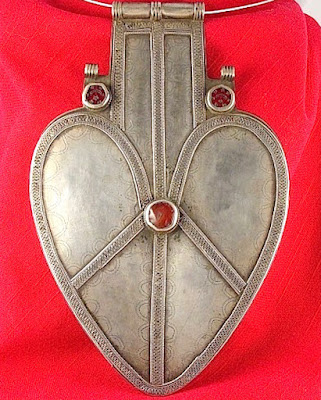Antique Yemen Silver Amulet, Large Silver Melon Beads Chain Necklace
Details
From my own collection of precious cultural relics of the Yemenites, I offer this antique Yemen silver amulet or prayer cylinder, large melon-shaped banded and striated silver beads in a traditional pattern of the early 1900s. Smaller silver beads separate the large beads from the amulet and from each other. All the beads and the amulet were made around 1900 and my family collected them around 2000 in Yemen. The Jewish silversmiths who did this kind of work had emigrated to Israel by 1948 and no one has made this kind of silver jewelry in Yemen since.
The jewel chest in the photo is also from Yemen, and is filled with amber beads from Yemen, but it is not for sale. It is appropriate to display this chain of large beads and the unusually decorated amulet near a wood chest, because they were part of a bride's dowry. Among the people of the Middle East, the dowry is the equivalent of a hope chest and wedding shower.
The family, the groom, and friends contribute the gifts of silver. Usually, those gifts, whether in coinage or in silver pieces from previous generations, are melted down and new beads, amulets, chains, veil and hair ornaments, rings, bracelets and anklets are made for the bride to wear on her wedding day and then to use as a treasury if she needs to spend it for necessities later in her marriage.
At the birth of each child, she will wear the jewelry again to receive the visitors who come to congratulate her.
Only the necklace is for sale, not the props in the photos.
The chain and fastener are modern antiqued silver plate.
Amulet is 26 mm diam x 7.6 cm long
The jewel chest in the photo is also from Yemen, and is filled with amber beads from Yemen, but it is not for sale. It is appropriate to display this chain of large beads and the unusually decorated amulet near a wood chest, because they were part of a bride's dowry. Among the people of the Middle East, the dowry is the equivalent of a hope chest and wedding shower.
The family, the groom, and friends contribute the gifts of silver. Usually, those gifts, whether in coinage or in silver pieces from previous generations, are melted down and new beads, amulets, chains, veil and hair ornaments, rings, bracelets and anklets are made for the bride to wear on her wedding day and then to use as a treasury if she needs to spend it for necessities later in her marriage.
At the birth of each child, she will wear the jewelry again to receive the visitors who come to congratulate her.
Only the necklace is for sale, not the props in the photos.
The chain and fastener are modern antiqued silver plate.
Amulet is 26 mm diam x 7.6 cm long
Price: $650 U. S. Contact me for invoice or with questions through the private message form at the top left of this page.



















